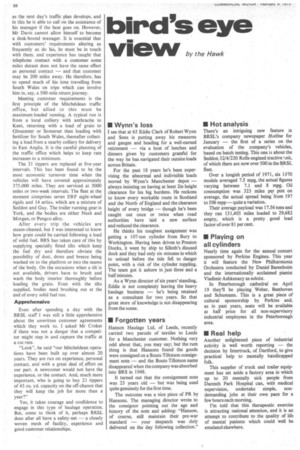bird's eye
Page 62

If you've noticed an error in this article please click here to report it so we can fix it.
viewby the Hawk
• Wynn's loss
I see that at 65 Eddie Clark of Robert Wynn and Sons is putting away his measures and gauges and heading for a well-earned retirement — via a host of lunches and dinners given by customers grateful for the way he has navigated their outsize loads across Britain.
For the past 18 years he's been supervising the abnormal and indivisible loads moved by Wynn's Manchester depot — always insisting on having at least 2in height clearance for his big burdens. He reckons to know every workable route in Scotland and the North of England and the clearance height of every bridge — though he's been caught out once or twice when road authorities have laid a new surface and reduced the clearance.
He thinks his toughest assignment was getting a 107-ton cylinder from Bury to Workington. Having been driven to Preston Docks, it went by ship to Silloth's disused dock and they had only six minutes in which to unload before the tide fell to danger point, with a risk of the cylinder toppling. The team got it ashore in just three and a half minutes.
As a Wynn director of six years' standing, Eddie is not completely leaving the heavy haulage business — he's being retained as a consultant for two years. So that great store of knowledge is not disappearing from the scene.
• Forgotten years
Hanson Haulage Ltd, of Leeds, recently carried two parcels of textiles to Leeds for a Manchester customer. Nothing very odd about that, you may say; but the rum thing is that Hansons found the goods were consigned on a Bouts-Tillotson consignment note — and the Bouts-Tillotson name disappeared when the company was absorbed into BRS in 1948.
It turned out that the consignment note was 23 years old — but was being used quite genuinely for the first time.
The outcome was a nice piece of PR by Hansons. The managing director wrote to the consignor pointing out the age and history of the note and adding: "Hanson, of course, still maintain their pre-war standard — your despatch was duly delivered on the day following collection."
• Hot analysis
There's an intriguing new feature in BRSL's company newspaper Hotline for January — the first of a series on the evaluation of the company's vehicles, based on batch testing. This one is about the Seddon, 32/4/220 Rolls-engined tractive 17.nit, of which there are now over 500 in the BRSL fleet.
Over a longish period of 1971, six 1970 models averaged 7.5 mpg, the actual figures varying between 7.1 and 8 mpg. Oil consumption was 323 miles per pint on average, the actual spread being from 197 to 506 mpp — quite a variation.
Their average payload was 17.56 tons and they ran 131,405 miles loaded to 29,682 empty, which is a pretty good load factor of over 81 per cent.
• Playing on all cylinders
Nearly time again for the annual concert sponsored by Perkins Engines. This year it will feature the New Philharmonia Orchestra conducted by Daniel Barenboim and the internationally acclaimed pianist Vladimir Ashkenazy as soloist.
In Peterborough cathedral on April 19 they'll be playing Weber, Beethoven and Schumann. This is a great piece of cultural sponsorship by Perkins and, as in past years, seats will be available at half price for all non-supervisory industrial employees in the Peterborough area.
• Real help
Another enlightened piece of industrial activity is well worth reporting — the decision by Intertruck, of Dartford, to give practical help to mentally handicapped folk.
This supplier of truck and trailer equipment has set aside a factory area in which up to 20 mentally sick people from Darenth Park Hospital can, with medical supervision, undertake simple, nondemanding jobs at their own pace for a few hours each morning.
I'm told that this therapeutic exercise is attracting national attention, and it is an attempt to contribute to the quality of life of mental patients which could well be emulated elsewhere.














































































































































